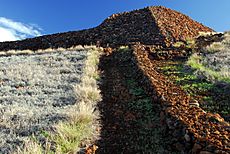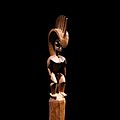Hawaiian religion facts for kids

The Hawaiian religion is the traditional set of beliefs and practices of the Hawaiian people. It began when Tahitians and other Pacific islanders first arrived in Hawaiʻi between the years 500 and 1300 AD. Today, the practices of the Hawaiian religion are protected by law.
Hawaiian religion is based on a belief called animistic. This means people believe that spirits can be found in many things that are not human. These include animals, the ocean waves, and the sky.
Hawaiian Gods and Stories
Hawaiian mythology tells the creation stories and legends about the gods. The Hawaiian religion has many gods and goddesses. The four most important gods are Kāne, Kū, Lono, and Kanaloa.
Groups of Gods
The figures in Hawaiian religion are often divided into different groups. One way to group them is:
- the four main gods (called ka hā) – Kū, Kāne, Lono, Kanaloa
- the forty male gods or different forms of Kāne (called ke kanahā)
- the four Hundred gods and goddesses (called ka lau)
- the great Multitude of gods and goddesses (called ke kini akua)
- the spirits (called na ʻunihipili)
- the guardians (called na ʻaumākua)
Another way to group them is into three main types:
- the four great gods, or akua: Kū, Kāne, Lono, Kanaloa
- many smaller gods, or kupua, each linked to certain jobs or skills
- family gods, called ʻaumakua, who protect specific families
Images for kids
-
A picture of a royal heiau (Hawaiian temple) at Kealakekua Bay, around 1816.
-
A portrait of King Kamehameha II.
-
Hula dancing during a ceremony at ʻIolani Palace in 2003. The Navy returned control of Kahoʻolawe to the State of Hawaiʻi.
See also
 In Spanish: Religión hawaiana para niños
In Spanish: Religión hawaiana para niños









